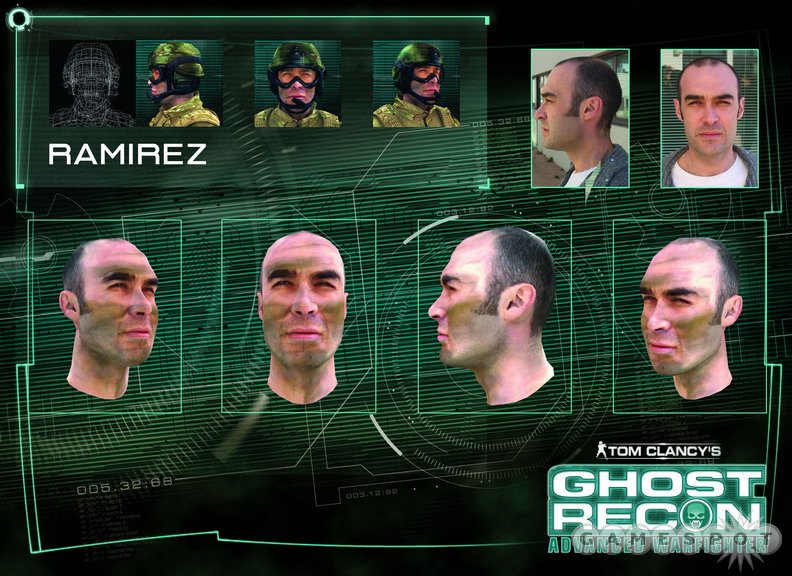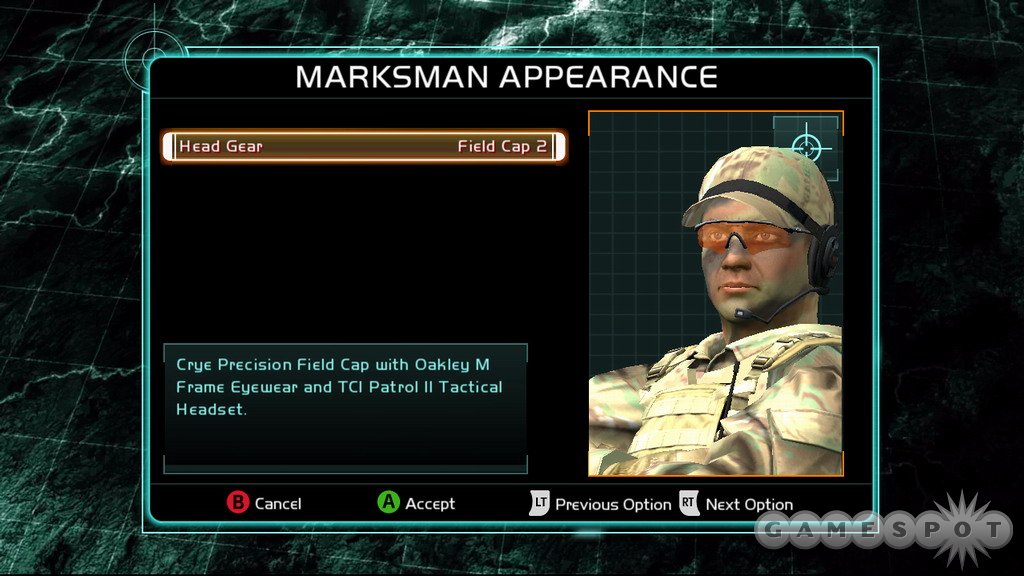Tom Clancy's Ghost Recon Advanced Warfighter Q&A -- Characters and Story
Meet the elite squad of ghosts you'll be commanding in GRAW in our character Q&A with Ubisoft's Pascal Lefort.
Drawing from a mixture of near-future technology and real-world geopolitical intrigue, Tom Clancy's Ghost Recon Advanced Warfighter takes the player through an adventure that is as exciting as it is plausible. Driving the plot of GRAW's gameplay are the tightly knit band of soldiers that make up the Ghost Recon unit. Here, in our third GRAW Q&A with Ubisoft, we take a closer look at some of the characters you'll see as you play through the game, courtesy of Ubisoft's Pascal Lefort, 3D character designer for the game.
GameSpot: Tell us about the cast of characters in the game.
Pascal Lefort: In the single-player campaign you embody Captain Scott Mitchell (first seen in Ghost Recon 2), who is leader of the Ghosts.
Name: Scott Mitchell
DOB: 08/13/76
Age: 35
Rank: Captain
Service: US Army, 7th SFG
Position: Ghost Team Leader
Scott Mitchell is a professional soldier. He believes that whatever job one does, one should do it to the best of one's abilities, and he applies that philosophy to soldiering.

As a leader, Mitchell leads by example and believes that respect is earned. He knows that his troops are the very best, and treats them like the professionals they are. In a military setting, he is a no-nonsense soldier. He puts the mission and his team first, and everything else is secondary. In the field, he leads by example and projects a calm and professional demeanour to his troops. He is apolitical, and doesn't concern himself with the politics of the missions.
Below are a few of the 10 ghosts you have to choose from during the single-player campaign. Every Ghost has their own specialist area that will give you support on the battlefield. In terms of gameplay, this translates into tactical decisions during your team selection at the Ghost truck. For example, if the objective involves an assault on an enemy base, then a gunner will provide you with strong suppressive fire to assist you in your assault. A marksman will provide cover over long distances and will be more adept in taking out enemy snipers.
Other Ghost Recon soldiers include:
Name: Joe Ramirez - Rifleman
DOB: 12/12/87
Age: 24
Rank: Sergeant First Class
Service: US Army, 7th SFG
Duties: Rifleman, Communications
Name: Marcus Brown - Gunner
DOB: 06/11/83
Age: 28
Rank: Sergeant
Service: US Army, 7th SFG
Duties: M240, 7.62 Machine Gunner, Heavy Support
Name: Alicia Diaz - Marksman
DOB: 09/14/81
Age: 30
Rank: Sergeant
Service: US Army, 7th SFG
Duties: Marksman
Name: Mike Kim - Marksman
DOB: 1/9/80
Age: 29
Rank: Sergeant
Service: US Army, 7th SFG
Duties: Marksman
GS: How do they fit in the story?
PL: In an era when the United States is the only global superpower, the US Army needs an elite group of soldiers who can be put in the field immediately, anywhere in the world. The point of the spear in every operation, US Special Forces Group 5, First Battalion, D Company is an elite Green Beret unit made up of the best of the best. First into any conflict and last to retreat, the Ghosts handle the missions that no one else can. Often inserted deep behind enemy lines, they strike swiftly and suddenly, and then vanish. They call themselves the "Ghosts."
Publicly, special forces soldiers are perceived as having a "kick ass, take no prisoner" approach to war, when in reality they are America's most professional and capable warriors. Among themselves, they like to be known as the "quiet professionals," a name that reflects the very nature of their trade.
The very nature of modern urban warfare lends itself to a small, elite team being inserted into enemy territory. For GRAW we wanted the player to feel the intensity of battle and not completely overwhelm the enemy with a huge military operation. The player has to play tactically and intelligently as he is outnumbered, in difficult and dangerous surroundings. For example, when moving through the built-up business area snipers are located high up, creating an intense vertical gameplay experience as well as one with enemies close up on the ground.
We chose Mexico City 2013 as it has diverse landscapes, but also due to it's proximity to the US and putting a plausible context to the story. The year also allowed us to explore future military technologies to fuel different tiers of gameplay, using UAV drones and the cross-com. This is why how we came up with the Integrated Warfighter System.

GS: Where did the inspiration for the characters come from?
PL: There has always been a focus for our Tom Clancy titles to ensure that the stories, characters, and equipment are as authentic as possible. With GRAW we wanted to ensure that this tradition continued, as fans of the brand have always enjoyed the realism that we convey in our games. As this is a next-generation title, we also wanted to give players the ability to play as the next-generation soldier--not sci-fi, but the kind of soldier you will see on the battlefield in the next 10 years.
In order to do this, there was a lot of research put into understanding what the US army and other military engineers were envisaging for the military in years to come. We worked very closely with our Special Forces advisors, equipment manufacturers, and various engineers to build our Integrated Warfighter System.
GS: How did you bring these fictional characters to life?
PL: There is an immense amount of research, travelling, and skill that goes in to producing the character for the Next-Generation hardware. We are constantly trying to improve the experience for players by giving them the most realistic entertainment experience you could imagine, and in order to do this, attention to detail is crucial.
With the power of the X360 we were able to make the models more realistic and detailed than ever before, as we had more than 15,000 polygons per Ghost; if I remember correctly, this was about the size of a whole map on an early PS1 game.
To ensure that we are using equipment that is realistic, we carry out an extensive research phase, where we talk to various military consultants, in the same way as the film industry has advisors. This way we have an insider's view of realistic future developments and how they will be used to improve tactics on the battlefield.
In order to reproduce the uniforms identically, we effectively dress up the model and target different areas of the body or head and take a series of photographs, in a similar way to that of motion capture. We then put it in 3DS max and create a cloud of key points, which allows us to create the model exactly in 3D.
The same process is repeated for the heads of our characters. We use real people in order to give the models a more realistic and human appearance in terms of expressions, hair, and detail. This allows us to have an incredible amount of detail for each of our Ghost Team and means the player can really get a feel of what soldiers will be equipped with in the near future.
GS: How do the characters differ from each other from a gameplay standpoint?

PL: As mentioned earlier, in single-player each character has his or her special strengths; we took this even further for multiplayer as we wanted to give more choice, so players can also create their own character identity from a range of visual options, as well as key ones that affect gameplay. On the visual side, you can choose a face for your identity, as well as choose from a whole range of real-world military gear (helmets, eyewear, headphones, and more) to customize the look of your character. Next, you choose the class going into the match, which affects how your weapons handle. This rewards the players and allows them to play the way they want to play without restricting them, so each class has a set of bonuses and negatives that affect weapon handling. For example, marksmen get a bonus for slow, controlled shots, while an automatic rifleman can handle recoil from suppressive fire much better. You can still take any weapon, but you will still get bonuses for playing the role you have chosen.
Last but not least is the way ranking is affected. You can choose from various different countries, and your rank (which are based on real military ranks), will change based on your country. This is also displayed on the leaderboards, so you can see which nation the top GR players are from.
Got a news tip or want to contact us directly? Email news@gamespot.com
Join the conversation